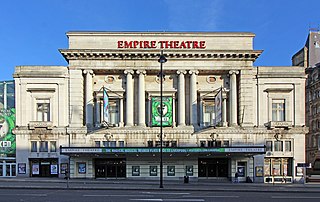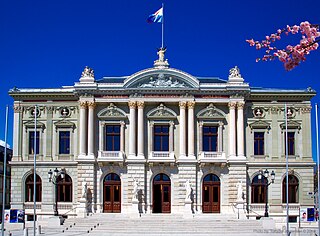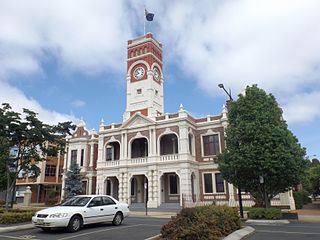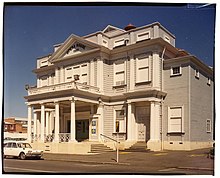
The Royal Opera House (ROH) is an opera house and major performing arts venue in Covent Garden, central London. The large building is often referred to as simply Covent Garden, after a previous use of the site. It is the home of The Royal Opera, The Royal Ballet, and the Orchestra of the Royal Opera House. The first theatre on the site, the Theatre Royal (1732), served primarily as a playhouse for the first hundred years of its history. In 1734, the first ballet was presented. A year later, the first season of operas, by George Frideric Handel, began. Many of his operas and oratorios were specifically written for Covent Garden and had their premieres there.

An auditorium is a room built to enable an audience to hear and watch performances. For movie theatres, the number of auditoria is expressed as the number of screens. Auditoria can be found in entertainment venues, community halls, and theaters, and may be used for rehearsal, presentation, performing arts productions, or as a learning space.

The Sondheim Theatre is a West End theatre located in Shaftesbury Avenue on the corner of Wardour Street in the City of Westminster, London. It opened as the Queen's Theatre on 8 October 1907, as a twin to the neighbouring Hicks Theatre which had opened ten months earlier. Both theatres were designed by W. G. R. Sprague. The theatre was Grade II listed by English Heritage in June 1972.

The Liverpool Empire Theatre is a theatre on the corner of Lime Street in Liverpool, England. The playhouse, which opened in 1925, is the second one to be built on the site. It has the largest two-tier auditorium in the United Kingdom and can seat 2,348 people.

The Theatre Royal is a historic theatre, a Grade I listed building situated on Grey Street in Newcastle upon Tyne.

The Sunderland Empire Theatre is a large theatre venue located in High Street West in Sunderland, North East England. The theatre, which opened in 1907, is owned by City of Sunderland Council and operated by Ambassador Theatre Group Ltd, on behalf of Sunderland Empire Theatre Trust.

A theater, theatre or playhouse, is a structure where theatrical works, performing arts and musical concerts are presented. The theater building serves to define the performance and audience spaces. The facility usually is organized to provide support areas for performers, the technical crew and the audience members, as well as the stage where the performance takes place.

Francis Matcham was an English architect who specialised in the design of theatres and music halls. He worked extensively in London, predominantly under Moss Empires, for whom he designed the Hippodrome in 1900, Hackney Empire (1901), Coliseum (1903) and Palladium (1910). His last major commission before retirement was the Victoria Palace (1911) for the variety magnate Alfred Butt. During his 40-year career, Matcham was responsible for the design and construction of over 90 theatres and the redesign and refurbishment of a further 80 throughout the United Kingdom.

His Majesty's Theatre in Aberdeen is the largest theatre in north-east Scotland, seating more than 1,400. The theatre is sited on Rosemount Viaduct, opposite the city's Union Terrace Gardens. It was designed by Frank Matcham and opened in 1906.

Mayflower Theatre is a Grade II listed theatre in the city centre of Southampton, England, with a capacity of 2,300. It features West End theatre shows when they tour the United Kingdom. In addition to this, one-off comedy shows and music events often take place at the theatre too.

Grand Théâtre de Genève is an opera house in Geneva, Switzerland.

His Majesty's Theatre is an Edwardian Baroque theatre in Perth, Western Australia. Constructed from 1902 to 1904 during a period of great growth for the town, the theatre is located on the corner of Hay Street and King Street in Perth's central business district.

The Theatre Royal in Bath, England, was built in 1805. A Grade II* listed building, it has been described by the Theatres Trust as "One of the most important surviving examples of Georgian theatre architecture". It has a capacity for an audience of around 900.

The Theatre Royal in Nottingham, England, is a theatre venue in the heart of Nottingham City Centre and is owned by Nottingham City Council as part of a complex that also includes the city's Royal Concert Hall. The Theatre Royal attracts major touring dramas, opera, ballet, West End musicals and an annual pantomime.

The King's Theatre is a theatre in Edinburgh, Scotland.

The Wolverhampton Grand Theatre, commonly known as The Grand, is a theatre located on Lichfield Street, Wolverhampton, UK, designed in 1894 by Architect Charles J. Phipps. It is a Grade II Listed Building with a seating capacity of 1200.

Toowoomba City Hall is a heritage-listed town hall at 541 Ruthven Street, Toowoomba, Toowoomba Region, Queensland, Australia. It was designed by Willoughby Powell and built in 1900 by Alexander Mayne. It is also known as Toowoomba Town Hall. It was added to the Queensland Heritage Register on 21 October 1992.

The Marina is a theatre and cinema in Lowestoft, Suffolk, originally opened in the Victorian era. The venue has an auditorium seating 800. It plays host to major West End productions, top comedy, orchestral concerts, touring drama and musical productions, opera, ballet, music, dance and celebrity concerts as well as operating a successful cinema operation - boasting the largest screen and cinema auditoria in the town. The Marina annually hosts the largest professional pantomime on the East Anglian Coast.

Majestic Picture Theatre is a heritage-listed theatre at 1 Eacham Place, Malanda, Tablelands Region, Queensland, Australia. It was designed by Bob Hassall and built in 1929 by Albie Halfpapp. It is also known as Majestic Theatre. It was added to the Queensland Heritage Register on 5 February 2010.

Her Majesty's Theatre, Brisbane (1888–1983), opened as Her Imperial Majesty's Opera House in Brisbane, Australia on 2 April 1888. It was the largest theatre in Brisbane. It was located at 193 Queen Street, Brisbane. Its façade was in the Italian Renaissance and Corinthian style.






















